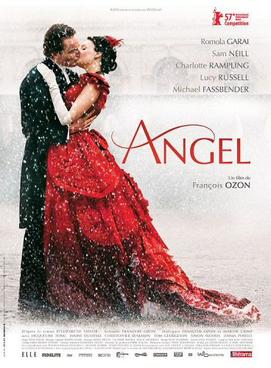To preface this post, I’m going to point out that I’m rarely a fan of the romance genre in any medium – books, movies, what-have-you. That being said, I was still drawn to watch the 2007 movie Angel starring Romola Garai. Perhaps it was because I’ve liked Ms. Garai in past movies or because the period piece tends to pull me in, but I ignored my impulse against the romance. Although, after viewing the movie, I’m not entirely sure that “romance” is the greatest descriptor for this film, given that it in no way follows the formulaic romantic plot. But I’m getting ahead of myself; I should start with a brief description of the movie.
Schoolgirl Angel Deverell has her teacher, mother, and aunt concerned as she always has her head in the clouds, writing up fantastical melodramas. By a stroke of luck, without any study or research, she writes a novel that is picked up by a major London publisher. She becomes a smash hit and writes novel after melodramatic novel, raking in tons of money while she’s at, allowing her to move from living above her mother’s grocery store to Paradise House, the mansion of her dreams. She also wins the admiration of poet Nora, who becomes her personal secretary and biggest admirer. But Angel has no interest in the passionate love of Nora, instead pursuing Nora’s brother Esme – a cheater, gambler, alcoholic, failed artist, and all-around louse. (Yeah, she can really pick a winner.) In hardly any time, Angel convinces Esme to marry her, and it seems as though her dreams are complete. But is life in Paradise all she dreamed after all?
I honestly don’t know where to start to review or critique this movie. I’m still a bit puzzled as to whether I was to take it seriously or view it as a parody of bad melodramatic romances. Some of the dialogue was so stilted and poor that it came across badly even in the hands of decent actors who I’ve admired in the past. There were several scenes where characters were meant to be riding about town or visiting other countries where the background shots were clearly green-screened in. By clearly, I mean obviously so, in the style of 1940 and 1950 movies when they didn’t have the technology to do better. While I generally watch movies more for plot and characters than effects, a movie should at least attempt to transport me away into its reality without making obvious gaffes that remind me that this is just a movie. So again, I’m left wondering is this something intentional to poke fun at the movie’s melodramatic story? Yet no clear answer emerges. And, in terms of plot and characters, I found little to be appealing. The plot is kind of rambling at times (although some things do eventually end up coming full circle) and, as I mentioned above, Esme is a textbook cad while Angel isn’t really a character you can wholeheartedly root for – she’s shallow and completely self-absorbed. The only saving grace for this film was the lush costumes and interiors of the period piece. But with so many other period pieces out there that are so much better done, this isn’t one I would recommend.
Luckily, romances got a reprieve this weekend with 12 Reasons Why I Love Her, a delightful romance comic that I thoroughly enjoyed.

Hmm, sounds like the characters are pretty hard to relate to. It's always hard with that, because you know people like that exist, but at the same time you are alienating most of the audience.
ReplyDeleteYeah, that was definitely part of it, but I think the hardest part for me to wrap my head around was whether I was supposed to be taking the movie seriously or viewing it as a parody. It was just so hard to tell.
ReplyDelete